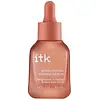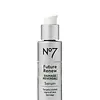What's inside
What's inside
 Key Ingredients
Key Ingredients

 Benefits
Benefits

 Concerns
Concerns

 Ingredients Side-by-side
Ingredients Side-by-side

Water
Skin ConditioningGlycerin
HumectantCoco-Caprylate
EmollientCaprylic/Capric Triglyceride
MaskingPropanediol
SolventSilica
AbrasiveAscorbyl Tetraisopalmitate
AntioxidantNiacinamide
SmoothingAscorbyl Glucoside
AntioxidantBiosaccharide Gum-1
HumectantPhenoxyethanol
PreservativePolyacrylate Crosspolymer-6
Emulsion StabilisingButylene Glycol
HumectantAminomethyl Propanol
BufferingC14-22 Alcohols
Emulsion StabilisingC12-20 Alkyl Glucoside
EmulsifyingPanthenol
Skin ConditioningEthylhexylglycerin
Skin ConditioningDisodium EDTA
Plukenetia Volubilis Seed Oil
EmollientAllantoin
Skin ConditioningDisodium Phosphate
BufferingSodium Lactate
BufferingCarbomer
Emulsion StabilisingSodium Hyaluronate
HumectantCalcium Dihydrogen Phosphate
BufferingPolysorbate 20
EmulsifyingTocopherol
AntioxidantPalmitoyl Tripeptide-1
Skin ConditioningPalmitoyl Tetrapeptide-7
Skin ConditioningWater, Glycerin, Coco-Caprylate, Caprylic/Capric Triglyceride, Propanediol, Silica, Ascorbyl Tetraisopalmitate, Niacinamide, Ascorbyl Glucoside, Biosaccharide Gum-1, Phenoxyethanol, Polyacrylate Crosspolymer-6, Butylene Glycol, Aminomethyl Propanol, C14-22 Alcohols, C12-20 Alkyl Glucoside, Panthenol, Ethylhexylglycerin, Disodium EDTA, Plukenetia Volubilis Seed Oil, Allantoin, Disodium Phosphate, Sodium Lactate, Carbomer, Sodium Hyaluronate, Calcium Dihydrogen Phosphate, Polysorbate 20, Tocopherol, Palmitoyl Tripeptide-1, Palmitoyl Tetrapeptide-7
Water
Skin ConditioningDimethicone
EmollientButylene Glycol
HumectantGlycerin
HumectantMethyl Gluceth-20
HumectantIsononyl Isononanoate
EmollientPolysilicone-11
Niacinamide
SmoothingPhenoxyethanol
PreservativeAcrylates/Beheneth-25 Methacrylate Copolymer
Tocopheryl Acetate
AntioxidantSilica
AbrasivePanthenol
Skin ConditioningPolysorbate 20
EmulsifyingCaprylyl Glycol
EmollientAmmonium Acryloyldimethyltaurate/Vp Copolymer
Potassium Hydroxide
BufferingXanthan Gum
EmulsifyingSodium Hyaluronate
HumectantHydrolyzed Rice Protein
Skin ConditioningDecyl Glucoside
CleansingPropylene Glycol
HumectantEthylhexylglycerin
Skin ConditioningAscorbyl Glucoside
AntioxidantPropanediol
SolventPentylene Glycol
Skin ConditioningTetrasodium EDTA
Hexylene Glycol
EmulsifyingT-Butyl Alcohol
PerfumingSodium Benzoate
MaskingMorus Alba Leaf Extract
Skin ConditioningPalmitoyl Tetrapeptide-94
Palmitoyl Tetrapeptide-95
Water, Dimethicone, Butylene Glycol, Glycerin, Methyl Gluceth-20, Isononyl Isononanoate, Polysilicone-11, Niacinamide, Phenoxyethanol, Acrylates/Beheneth-25 Methacrylate Copolymer, Tocopheryl Acetate, Silica, Panthenol, Polysorbate 20, Caprylyl Glycol, Ammonium Acryloyldimethyltaurate/Vp Copolymer, Potassium Hydroxide, Xanthan Gum, Sodium Hyaluronate, Hydrolyzed Rice Protein, Decyl Glucoside, Propylene Glycol, Ethylhexylglycerin, Ascorbyl Glucoside, Propanediol, Pentylene Glycol, Tetrasodium EDTA, Hexylene Glycol, T-Butyl Alcohol, Sodium Benzoate, Morus Alba Leaf Extract, Palmitoyl Tetrapeptide-94, Palmitoyl Tetrapeptide-95
 Reviews
Reviews

Ingredients Explained
These ingredients are found in both products.
Ingredients higher up in an ingredient list are typically present in a larger amount.
Ascorbyl Glucoside is a stable form of Vitamin C. It is created by combining glucose from starch.
When applied to skin, Ascorbyl Glucoside turns into Ascorbic Acid.
Ascorbyl Glucoside is an antioxidant. Antioxidants help fight free-radicals, or molecules that may damage skin cells.
It can help to reduce redness, improve skin texture, reduce the effects of aging, reduce the visibility of dark spots, and brighten skin.
Read more about other types of Vitamin C:
Learn more about Ascorbyl GlucosideButylene Glycol (or BG) is used within cosmetic products for a few different reasons:
Overall, Butylene Glycol is a safe and well-rounded ingredient that works well with other ingredients.
Though this ingredient works well with most skin types, some people with sensitive skin may experience a reaction such as allergic rashes, closed comedones, or itchiness.
Learn more about Butylene GlycolEthylhexylglycerin (we can't pronounce this either) is commonly used as a preservative and skin softener. It is derived from glyceryl.
You might see Ethylhexylglycerin often paired with other preservatives such as phenoxyethanol. Ethylhexylglycerin has been found to increase the effectiveness of these other preservatives.
Glycerin is already naturally found in your skin. It helps moisturize and protect your skin.
A study from 2016 found glycerin to be more effective as a humectant than AHAs and hyaluronic acid.
As a humectant, it helps the skin stay hydrated by pulling moisture to your skin. The low molecular weight of glycerin allows it to pull moisture into the deeper layers of your skin.
Hydrated skin improves your skin barrier; Your skin barrier helps protect against irritants and bacteria.
Glycerin has also been found to have antimicrobial and antiviral properties. Due to these properties, glycerin is often used in wound and burn treatments.
In cosmetics, glycerin is usually derived from plants such as soybean or palm. However, it can also be sourced from animals, such as tallow or animal fat.
This ingredient is organic, colorless, odorless, and non-toxic.
Glycerin is the name for this ingredient in American English. British English uses Glycerol/Glycerine.
Learn more about GlycerinNiacinamide is a multitasking form of vitamin B3 that strengthens the skin barrier, reduces pores and dark spots, regulates oil, and improves signs of aging.
And the best part? It's gentle and well-tolerated by most skin types, including sensitive and reactive skin.
You might have heard of "niacin flush", or the reddening of skin that causes itchiness. Niacinamide has not been found to cause this.
In very rare cases, some individuals may not be able to tolerate niacinamide at all or experience an allergic reaction to it.
If you are experiencing flaking, irritation, and dryness with this ingredient, be sure to double check all your products as this ingredient can be found in all categories of skincare.
When incorporating niacinamide into your routine, look out for concentration amounts. Typically, 5% niacinamide provides benefits such as fading dark spots. However, if you have sensitive skin, it is better to begin with a smaller concentration.
When you apply niacinamide to your skin, your body converts it into nicotinamide adenine dinucleotide (NAD). NAD is an essential coenzyme that is already found in your cells as "fuel" and powers countless biological processes.
In your skin, NAD helps repair cell damage, produce new healthy cells, support collagen production, strengthen the skin barrier, and fight environmental stressors (like UV and pollution).
Our natural NAD levels start to decline with age, leading to slower skin repair, visible aging, and a weaker skin barrier. By providing your skin niacinamide, you're recharging your skin's NAD levels. This leads to stronger, healthier, and younger looking skin.
Another name for vitamin B3 is nicotinamide. This vitamin is water-soluble and our bodies don't store it. We obtain Vitamin B3 from either food or skincare. Meat, fish, wheat, yeast, and leafy greens contain vitamin B3.
The type of niacinamide used in skincare is synthetically created.
Learn more about NiacinamidePanthenol is a common ingredient that helps hydrate and soothe the skin. It is found naturally in our skin and hair.
There are two forms of panthenol: D and L.
D-panthenol is also known as dexpanthenol. Most cosmetics use dexpanthenol or a mixture of D and L-panthenol.
Panthenol is famous due to its ability to go deeper into the skin's layers. Using this ingredient has numerous pros (and no cons):
Like hyaluronic acid, panthenol is a humectant. Humectants are able to bind and hold large amounts of water to keep skin hydrated.
This ingredient works well for wound healing. It works by increasing tissue in the wound and helps close open wounds.
Once oxidized, panthenol converts to pantothenic acid. Panthothenic acid is found in all living cells.
This ingredient is also referred to as pro-vitamin B5.
Learn more about PanthenolPhenoxyethanol is a preservative that has germicide, antimicrobial, and aromatic properties. Studies show that phenoxyethanol can prevent microbial growth. By itself, it has a scent that is similar to that of a rose.
It's often used in formulations along with Caprylyl Glycol to preserve the shelf life of products.
Polysorbate 20 is made by combining ethoxylation of sorbitan, ethylene oxide, and lauric acid. It is a mild cleansing agent, surfactant, and emulsifier.
As a surfactant, it helps collect dirt and oils for washing. Emulsifiers prevent oils and water from separating.
Polysorbate 20 also adds scent to a product. Since it is made using sorbitol, it has a sweet scent. Sorbitol can also be found in fruits such as apples and peaches.
The lauric acid used to create Polysorbate 20 is often derived from coconuts.
Polysorbate 20 may not be fungal acne safe.
Learn more about Polysorbate 20Propanediol is an all-star ingredient. It softens, hydrates, and smooths the skin.
It’s often used to:
Propanediol is not likely to cause sensitivity and considered safe to use. It is derived from corn or petroleum with a clear color and no scent.
Learn more about PropanediolSilica, also known as silicon dioxide, is a naturally occurring mineral. It is used as a fine, spherical, and porous powder in cosmetics.
Though it has exfoliant properties, the function of silica varies depending on the product.
The unique structure of silica enhances the spreadability and adds smoothness, making it a great texture enhancer.
It is also used as an active carrier, emulsifier, and mattifier due to its ability to absorb excess oil.
In some products, tiny microneedles called spicules are made from silica or hydrolyzed sponge. When you rub them in, they lightly polish away dead skin layers and enhance the penetration of active ingredients.
Learn more about SilicaSodium Hyaluronate is hyaluronic acid's salt form. It is commonly derived from the sodium salt of hyaluronic acid.
Like hyaluronic acid, it is great at holding water and acts as a humectant. This makes it a great skin hydrating ingredient.
Sodium Hyaluronate is naturally occurring in our bodies and is mostly found in eye fluid and joints.
These are some other common types of Hyaluronic Acid:
Learn more about Sodium HyaluronateWater. It's the most common cosmetic ingredient of all. You'll usually see it at the top of ingredient lists, meaning that it makes up the largest part of the product.
So why is it so popular? Water most often acts as a solvent - this means that it helps dissolve other ingredients into the formulation.
You'll also recognize water as that liquid we all need to stay alive. If you see this, drink a glass of water. Stay hydrated!
Learn more about Water